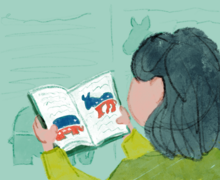Professor discusses negative media portrayal of Haudenosaunee historical events
Kennedy Rose | News Editor
Susan Hill is an associate professor of Indigenous studies and history at the University of Toronto.
More than two dozen people sat in Bird Library’s Scholarly Commons room Tuesday afternoon to hear a lecture on rethinking indigenous historical events portrayed by the Jesuit Relations.
Susan Hill, associate professor of indigenous studies and history at the University of Toronto, deconstructed a series of documents written by Jesuit missionaries about their experiences in the Americas describing Haudenosaunee peoples in the 17th century.
Hill is a member of the Grand River Haudenosaunee, in the Mohawk Nation/Wolf Clan, and is the author of “The Clay We Are Made Of: Haudenosaunee Land Tenure on the Grand River.”
In the Jesuit Relations, missionaries described a litany of “Iroquois attacks” on settlements throughout the northeastern U.S. between 1645 and 1655, Hill said. One report detailed 10,000 “Mohawk warriors” attacking a town, Hill said. Due to a 75 percent decrease in Mohawk population from 1630 to 1640, the attack would have required the participation of every man, woman and child of the Haudenosaunee, she said.
The whole Haudenosaunee population also experienced a massive population decline in that time, Hill added.
Other reports described murder and cannibalism allegedly committed by the Haudenosaunee, particularly the consumption of children and babies, Hillsaid.
“When we think about this based on what we know of Haudenosaunee values, I would suggest to you that it is highly unlikely, highly unlikely, particularly that we would take the lives of children,” Hill said.

Anna Henderson | Digital Design Editor
She expressed concern with accepting historical accounts at face value, as well as continuing to tell historically-accepted stories that reproduce harmful binaries. For example, Hill said despite the fact that the Haudenosaunee do things in certain ways according to tradition, they accommodate for diversity and free will. Historical representations often do not acknowledge that, she said.
Hill also suggested that audience members pursue the study of indigenous languages to help them better understand the nuance, traditions and governance of the Haudenosaunee in their work. Much of what people understand of the Haudenosaunee is derived from translations, and learning the language could help clear up misconceptions, Hill said.
“I’m not suggesting that the Jesuit Relations and other missionary records aren’t valuable. I’m suggesting that you be careful in how you use them,” Hill said.
During her undergraduate years studying United States history at the University of Michigan, she noticed that her classes were “democracy-focused”: professors often romanticizedthe founding of America.
When she took a colonial U.S. history class, which covered the period from 1607 to 1801, she noticed that her professor said the word “Indian” twice throughout the entirety of the course.
“We were at best, two tiny little footnotes to his story about the founding of America,” she said.
Her first introduction to the Jesuit Relations came while watching the 1991 movie “Black Robe.” The film, depicting a Jesuit priest seeking to convert indigenous tribes in Canada, has Iroquois characters capture, kill and torture members of the exposition.
“I walked out of the movie theater in shock,” Hill said.
The filmmakers said it was based on true stories from the Jesuits Relations, which prompted Hill to explore what the documents were. She researched the documents and toured the University of Michigan’s Clements Historical Library, which she was told had one of the first editions of the Jesuit Relations. Now, she said she can only handle reading the Jesuit Relations for a few hours at a time before needing to take a break, she said.
“This body of literature had so much power over how my people were represented in the historic record,” she said.
Published on March 5, 2019 at 10:46 pm
Contact Kennedy: krose100@syr.edu | @KennedyRose001






